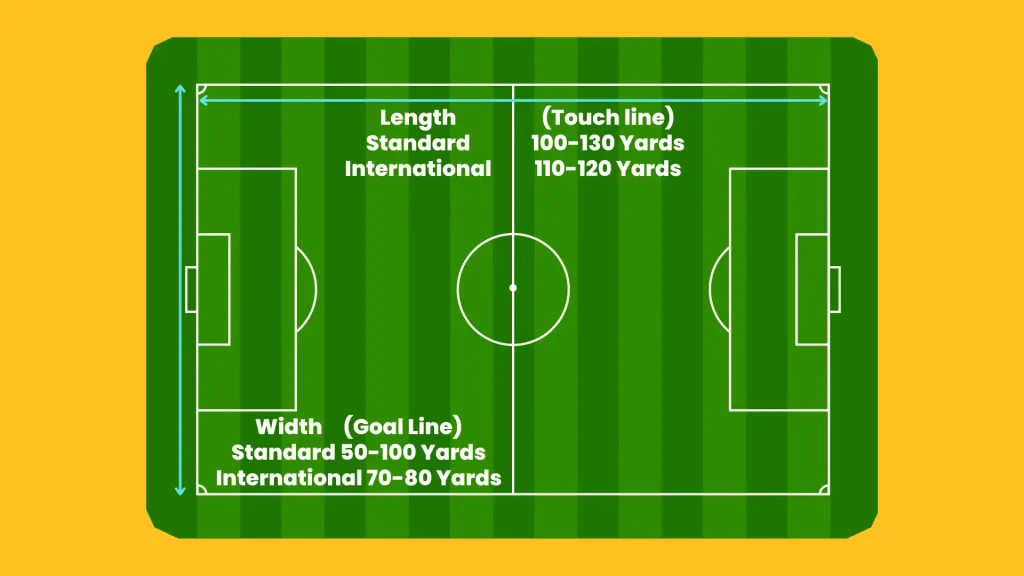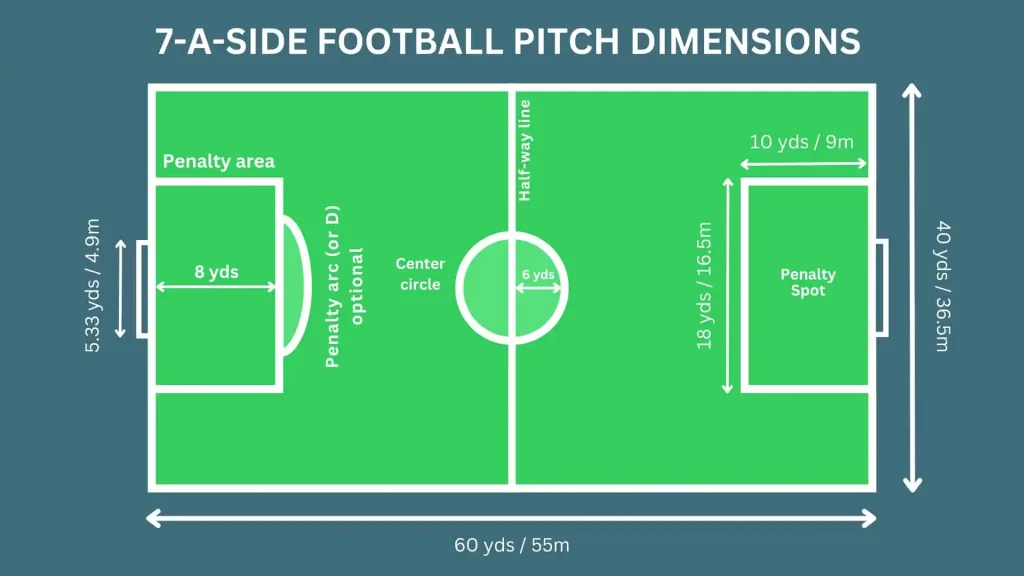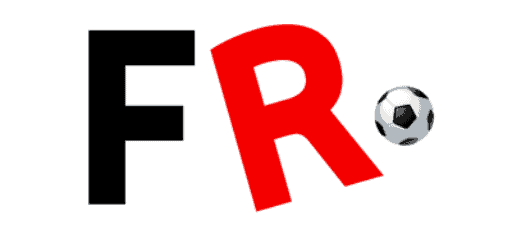
A football pitch, also known as a soccer field, is a specially built playing surface used for football (soccer). In sports language, pitch means playing area; in some countries, playing field is also known as pitch. In this article, we will review football Pitch. Football pitch means the field or playing area where a football match is played.
Table of Contents
The dimensions and features of a football pitch are carefully established to ensure fair play and the integrity of the game.
A football pitch is often a rectangle or oval-shaped field with particular markings to designate the boundaries, penalty areas, goal boxes, and center circle.
The playing field can be natural grass, artificial turf, or a hybrid system. Each surface type offers advantages and considerations regarding maintenance, performance, and environmental impact.
The goalposts are a conspicuous and significant element on a football field at each end of the area.
They are made up of upright posts with a crossbar in the middle and serve as the objective for players to shoot for when trying to score goals.
When a goal is scored, the proper netting is positioned behind the goalposts to capture and confine the ball after it has been kicked into play.
Football pitches and soccer fields need frequent upkeep to provide optimal playing conditions.
This involves mowing the grass, watering, fertilizing, and repairing damage. Adequate irrigation and drainage systems are essential for preventing waterlogging and ensuring the pitch’s durability.
Football pitches are more than just a playing surface; they are dynamic environments where athletes, teams, and fans come together to enjoy the excitement and emotion of the sport.
The skill, cooperation, and competition moments on these fields leave an indelible mark on the players, spectators, and those who watch them.
TYPES OF PITCHES:
The type of pitch chosen is determined by criteria such as climate, available space, level of play, and intended purpose, with each presenting its own set of advantages and considerations.
GROSS PITCHES:
Natural grass pitches are the most conventional and extensively utilized form of a football pitch.
They provide a natural playing surface and are often made of grasses such as Bermuda grass or Kentucky bluegrass.
Grass pitches require frequent maintenance, such as mowing, watering, and fertilizer, to sustain optimum playing conditions.
ARTIFICIAL TURF PITCHES:
Artificial turf pitches, also known as synthetic pitches or all-weather pitches, have grown in popularity due to their longevity and ability to resist extensive use.
They are made of synthetic fibers on a base layer of compacted stone or rubber granules, usually nylon or polyethylene.
Artificial turf fields provide consistent playing characteristics, are less impacted by weather conditions, and require less upkeep than grass fields.
HYBRID PITCHES:
Hybrid pitches combine natural grass with artificial turf. They consist of a base layer of natural grass with synthetic fibers integrated into the surface.
Adding artificial elements increases durability and stability, allowing the pitch to withstand heavy usage and adverse weather conditions.
Hybrid pitches are commonly used in professional stadiums where maintaining a high-quality playing surface is crucial.
FUTSAL PITCHES:
Futsal is a football variant played on a smaller pitch with distinct rules.
Futsal fields with a hard, smooth surface are often smaller than standard football fields. They are usually constructed from wood, synthetic flooring, or specialist futsal turf.
The small size of the rise, as well as the surface qualities, encourage fast-paced, skillful play.
BEACH PITCHES:
Beach football is often played on sandy surfaces near the shoreline. These pitches are distinguished by loose sand, which adds to the game’s difficulty.
Sand has a softer texture and absorbs impact, lowering the chance of injury. Beach pitches are frequently temporary and can be set up for tournaments or recreational play in various places.
LENGTH OF FOOTBALL PITCH:
The size of a football field varies immensely depending on the format of the game, as not all football fields are the same size. Regardless of your position at a club, it is crucial to be familiar with the dimensions of a football pitch.
To indicate the breadth of the playing field, pitches were typically around 200 yards long when they were first constructed in the early 1800s.
At the turn of the nineteenth century, playing fields started to adopt and employ lines to demarcate the perimeter of the playing space. This practice continued until the early twentieth century.
Although all pitches are not the same size, according to FIFA’s recommendation, the field of play dimensions are 105 Meters(Approx. 115 yards long) x 68 Meters(Approx. 75 yards wide), as a field of play is the area bounded by the goal lines and touchlines.
The playing ground must be ultimately level and free of any undulations. The field of play is a part of the grassed area, but the grassed area extends beyond the limits of the field to include other places covered by turf.
These additional areas include warm-up spaces for players and locations for assistant referees.
FIFA requires five meters beyond each goal line and four meters beyond each touchline before placing peripheral advertising boards in more giant stadiums.
FIFA recommends four meters behind each goal line and three meters beyond each touchline before placing peripheral advertising boards in more minor stadiums.
PITCH SURROUNDING AREA:
The playing field also includes, in addition to the grassy area and the advertising boards, an additional space that may be utilized for the placement of personnel such as photographers and security guards, amongst other people.
In an ideal situation, the playing field should be supported by permanent installations, walkways, staircases, or emergency exits from the spectator stands. This will allow for unrestricted movement all around the playing field.
The pitch area should be completely covered in a substance that prevents slipping on any surface.
The spectator-watching zones and any other boundaries are considered to be beyond the pitch area, which encompasses the playing field and the surrounding grassy area that extends beyond it.
PITCH PERIMETER:
The playing area, or the competition area, is separated from the viewing areas for spectators by the pitch perimeter.
Emergency entry points/gates should be built into the pitch perimeter. If a barrier is used, this could take the shape of crossing points.
Exceptions to the above can be considered where there are good alternate exit routes for spectators, subject to the consent of the local safety authorities. Any fence or barrier must be manageable, and alternate exits must be offered.
One method is to provide more entry points to the pitch area. Suppose the gates have a remote-controlled opening mechanism. In that case, each gate must also have a manual override facility to be opened manually in an emergency.
WARM-UP AREAS:
When separate warm-up zones are located behind each goal, the FIFA recommended size for each area is 3m x 30m for six players and two officials.
If it is more practicable to position the warm-up area behind the assistant referee, the stadium configuration will determine the dimensions.
Usually, the pitch area would have two warm-up spaces. The warm-up area should be located behind each goal (as well as any placed perimeter boards and photographers’ locations).
LIST OF SOCCER FIELD FIELD EXPLANATIONS:

- Penalty Arc
- Penalty Kick Mark
- Sideline
- End-line
- Halfway Line
- Center Circle
- Corner Arc
- Goal Box
- Penalty Box
FOOTBALL PITCH DIMENSIONS(w.r.t NUMBER OF PLAYERS):
| FORMAT | Length | Width |
| 5-A-side | 40-Yards | 30-Yards |
| 7-A-side | 60-Yards | 40-Yards |
| 11-A-side | 115-Yards | 75-Yards |
5-A

7-A

11-A

FOOTBALL PITCH DIMENSIONS(w.r.t Age group)
| AGE GROUP | EACH TEAM PLAYERS | LENGTH | WIDTH |
| U7-U8 | Five vs. Five | 40-Yards | 30-Yards |
| U9-U10 | Seven vs. Seven | 60-Yards | 40-Yards |
| U11-U12 | Nine vs. Nine | 80-Yards | 50-Yards |
| U13-U14 | Eleven vs.Eleven | 90-Yards | 55-Yards |
| U15-U16 | Eleven vs. Eleven | 100-Yards | 60-Yards |
U7/U8
The Football Association recommends that children ages 7 and 8 play a version of football called Mini Soccer, which only allows five players on each team
to be on the pitch simultaneously. In addition, the teams compete with a ball of size three and goals with dimensions of 12 meters by 6 meters
According to the data in the table above, the ideal dimensions for a pitch are forty yards by thirty yards.
U9/U10
Under the ages of nine and ten, leagues are required to play matches with seven players competing concurrently. The dimensions of the field should be 60 yards by 40 yards. The optimal ball for the game is a size three, and the dimensions of the goals should be 12 feet by 6 feet.
U11/U12
The U11/12 clubs and games should be played with a nine-on-nine player format, goals measuring 16 feet by 7 feet, and a ball of four inches in diameter. It is recommended that the pitch be 80 yards long and 50 yards wide.
U13/U14
Both the under-thirteen and under-fourteen teams will play simultaneously, with eleven players from each squad allowed on the pitch. The goalposts should be 21 feet by 7 feet in size, and the ball must be a size four.
The field length should be 90 yards, while the width should be 55 yards.
U15/U16
A football field for 15- and 16-year-olds should be 100 yards long (91.44 meters), 60 yards wide (54.86 meters), and the goals should be full size (24 feet tall, 8 feet wide). The age group plays 11 vs. 11.
Each goal post should be located twelve yards (10.97 meters) away from the penalty spot, and the penalty box should have dimensions of eighteen yards by forty-four yards.
The required dimensions for the net are 6 yards (5.49 meters) by 20 yards (18.29 meters).
U17/U18 & Seniors:
Senior pitch sizes are used when a player reaches the age of 17.
According to IFAB(International Football Association Board) rules, football fields can be 100-Yards to 130-Yards long and 50-Yards to 100-Yards wide.
These dimensions vary at the amateur level.
PITCH MARKINGS FOR FOOTBALL:
The markings on a football field are crucial to the outcome of every game. Lines on football fields are essential at all levels of play, whether they indicate when the ball is in or out of space, when a goal has been scored, or when a penalty should be awarded.
Not only are there prescribed pitch line configurations but also prescribed pitch dimensions.
Notably, according to the most recent Football Association, the white lines restricting a football field ” should be of the same width and no wider than 5 inches.”
PENALTY BOX MEASUREMENTS EXPLANATION:
A penalty area referred to as the “18-yard box” can be found in front of each goal.
When the other team makes a foul inside the penalty area, the team that is now on offense receives a penalty. The only exception to this rule is when the team that is pursuing is given an indirect free kick.
Despite its name, the penalty box is just 18 yards (16.5 meters) broad and 44 yards (40.2 meters) long. Its length is 18 yards (16.5 meters), and its width is 44 yards (40.2 meters).
The width of the penalty box in most games is established by measuring the distance in yards from each goalpost.
Given that a full-size goal is 8 yards (7.32 meters) wide, the overall width is 44 yards (40.2 meters).
Inside the penalty area is where you’ll find the penalty spot. This should be marked 12 yards (10.97 meters) away from the goal line, near the center of the goalposts. When a penalty is called, the only people allowed to stand inside the arc or box are the goaltender and the player chooses to take the penalty.
SPECIFICATION OF GOAL AREA:
The goal area, commonly referred to as “the six-yard box,” has dimensions of 6 yards along each side and 20 yards in the middle. The goal area’s major function is to define limits around the room, limiting where the ball can be placed for a goal kick. The objective site is used to do this.
DIMENSIONS OF THE CENTER CIRCLE:
On a football pitch, the radius of the center circles a measurement of 10 yards (9.14 meters). When a kick-off is taken from the center, all competitors must wait outside the center circle until the ball is touched or kicked into play before entering the action.
This regulation only applies when kicking off from the center position. The game begins with a kick-off, and after a goal is scored, the fun continues with another kick-off.
Furthermore, all players (excluding the individual taking the penalty and the custodian) must remain within the center circle during a penalty shootout.
The penalty-takers custodian must be along the touchline, generally near the assistant referee, and in line with the 18-yard alignment of the penalty box.
MEASUREMENTS OF CORNER ARCS:
A corner arc has a radius of one yard (0.91 meters). A quarter circle symbolizes the angle the distance from the base of the corner flag to the center of the process is one yard.
The ball must be within the arc when a corner kick is performed.
Defending players must stay 10 yards (9.15 meters) away from the ball until it is kicked.
CONCLUSIONS:
A well-kept surface is critical to the success of any football match. The general condition, size, and surface quality significantly impact the participants’ performance and game dynamics. Adequate drainage, good marking, and routine maintenance are critical components in guaranteeing good playability and safety.
A good football pitch is necessary for clubs, schools, and sports centers. The correct building materials, such as natural or artificial turf, can improve playability while lowering the danger of injury.
FAQS:
How Big is a Football Pitch? / How long Is a Soccer field?
According to FIFA's recommendation, the field of play dimensions are 105 Meters(Approx. 115 yards long) x 68 Meters(Approx. 75 yards wide), as a field of play is the area bounded by the goal lines and touchlines.
How Big is a Football Pitch In Acres? / How Many Acres In A Football Pitch?
Let us calculate;
According to FIFA's recommendation, the field of play dimensions are 105 Meters x 68 Meters:e 7140 sq meters, equal to 1.76 Acres.
How many Lines are On a Football Pitch?
On a football pitch, there are nine lines: the sideline, the end line, the goal line, the midfield line, the goal box, the penalty box, the penalty arc, the corner arc, and the center circle. These nine lines are referred to collectively as the 'boxes.
How many yards is a soccer field?
According to FIFA's recommendation, the field of play dimensions are 114.83(Approx. 115 yards) long x 74.37(Approx. 75 yards) wide
How Many Players on a Soccer Field?
Football is played by two teams, each comprised of 11 players, with one member on each team designated as the goalkeeper. This is by the Laws of the Game.
What Is a 3g Football Pitch?
When someone plays football on an artificial surface that resembles grass and is used to cover fields, we learn about 2G, 3G, and G football pitches. This is because these surfaces are used to cover the areas.
The 3G football pitch is made of Long leaves of synthetic grass that contain rubber crumbs for shock absorption. It is the best surface for football, safer, and more realistic than 2G.
What Is a 4g Football Pitch?
It is the fourth Generation surface that consists of Synthetic grass without the need for rubber crumb. These surfaces have yet to reach their initial stages of growth and are not recognized by any governing body.
